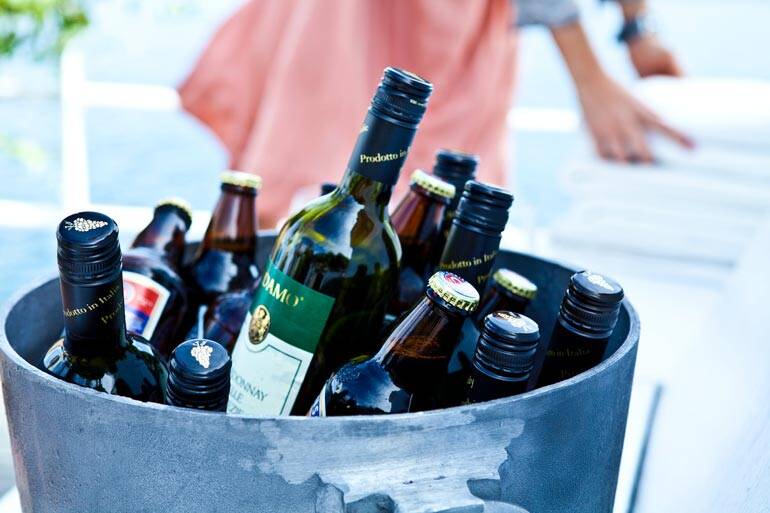Start 14-Day Trial Subscription
*No credit card required

Beer vs. Wine: Surprising Commonalities You Never Knew Existed
Discover the unexpected similarities between beer and wine, from aromas to sweetness, acidity, and even wine/beer hybrids. Uncover the fascinating world where these two drinks intersect.
I’m sure many beer and wine enthusiasts would think this is a preposterous idea. How can these two diametrically opposite drinks have anything in common other than the fact that they are both fermented beverages?
Wine enthusiasts think that beer is a common person’s drink that lacks class or style. On the other hand, beer lovers feel that wine belongs in the hands of the snooty and snobbish. And who can blame them? The flavor profiles definitely seem at odds with each other.
But can there be common ground at all between wine and beer? Let’s find out.
The Basic Similarities
I would argue that there are some similarities between beer and white wine in terms of appearance. The color of white wine comes from the pigments present in grape skins, which depends on the variety and the wine’s oxidation levels. On the other hand, the color of beer usually depends on the degree to which its malt is roasted. Lighter roasts are used to make pilsners or lagers, while dark roasts are used for ales, porters and stouts.
But I’m sure you would never confuse a beer for a white wine just by its appearance, right? Maybe a light pilsner can pass for sparkling wine in terms of looks if it is served in a wine glass and the head has disappeared. But other than that, it’s highly unlikely. However, there are some basic similarities between wines and beers.
Aromas
I’m not saying beer and wine smell the same. But there are some common grounds in the aromatic profiling of both. Tasters often assess the intensity of a beer or a wine based on its aroma that develops during the making and maturing process. There are some common aromas that tasters often look for, such as:
- Floral characteristics
- Fruitiness (citrusy, tropical, red, black, etc.)
- Herbal notes
- Spicy hints
- Malolactic characteristics
Obviously, you can’t find these aromatic characteristics in all beers and wines, but I’m sure you’ve heard connoisseurs mentioning them while drinking or tasting them.
Sweetness
Both wine and beer have varying levels of sweetness. Some are extremely dry, whereas others are sweet on the tongue. I was amazed when I found out that dessert beers exist, too. For those unaware, dessert beers are usually made with caramel or crystal malts with high residual sugar content and can be sinfully sweet.
And I’m sure I don’t have to tell you about sweet wines like Sauternes. As My Wine Love rightly points out in a blog, the quality of sweet wine is determined by the grape variety used, the climatic conditions of the location and the intricacies of harvesting and fermenting.
Acidity
Usually, wines are more acidic than beers, with pH levels between 3.0 to 3.6. On the other hand, beers usually have a pH value of 4.0 to 4.5. However, some beers like Flanders or Berliner Weiss can be as acidic as wines, with pH levels between 3.2 and 3.5. However, there’s a distinct difference in the sourness of beers and wines due to the chemistry. Wines develop tartaric acid, whereas beers have lactic or acetic acids.
Bitterness or Tannins
Tannins or bitterness is another common factor between wines and beers, although the bitterness varies in terms of its effect on the palate. Tannins in beers? You think I’m joking, right? Au contraire, my friend. If you believe hops are responsible for the bitterness in beers, that’s because of the tannins present in them.
And yes, these tannins are the same as what’s present in the skin and stalks of grapes. However, hops only contribute to about one-third of the tannins present in beer. The remaining two-thirds comes from the husk of the malt or barley. Usually, tannins range between 150 to 330 mg/l in most beers, but the ratio of tannins derived from hops and husk can vary depending on the beer’s gravity and the amount of hops used.
Wine/Beer Hybrids
The first time I heard of it, I was reminded of Tom Hiddleston playing F. Scott Fitzgerald in Midnight in Paris: “You’ll forgive me, I’ve been mixing grain and grappa.” But does the unsavory hangover also happen if you mix grain and grape in the production process?
Turns out, the Belgians have been making lambic beers using fruits, including grapes, for years, if not centuries. The most notable use can be traced back to the 1970s when Muscat grapes were used by the legendary producer Cantillon in lambic beers. But let’s see what some of the modern brewers are doing with this combination.
Italian Grape Ale
The Italian Grape Ale, or IGA, is another old example of adding grapes to the beer-making process. Even though some examples of wine/beer combinations entail blending the two, that’s prohibited by law in Italy.
Hence, the IGA uses grapes during the brewing process. Only Italian grapes can be used in making IGA, and the most popular varieties are Marzemino and Manzoni, a cross between Riesling and Pinot Blanc.
Vière
It seems the French don’t want to feel left behind in this trend of mixing grain and grape. People in Paris recently witnessed advertisements for a beverage called Vière. The manufacturer, Gallia, mentions on its website that it is indeed a mixture of vin (wine) and bière (beer). Gallia was founded in 1890 in Paris and then later revived in 2010. It was finally bought by Heineken in 2021.
The grapes are obtained from Loire Valley, Ardèche and Alsace and left to macerate. When the master brewer, Rémy Maurin, feels that the time is right, sour beer wort with barley and wheat malt is added to the mix and fermented to make the beverage. Vière comes in a 750ml bottle and is served in a wine glass instead of a pint glass.
Oenobeer
Oenobeer (pronounced N-O-beer) does not have an official definition, but its rising popularity can be credited to Alex Librati, who launched a brewery dedicated to the concept. The Italian native opened one of the first craft beer bars in Rome called Brasserie 4:20 in 2007. However, he shifted the brewery to Denver, Colorado, due to bureaucratic and financial issues in his home country.
Unfortunately, Librati’s brewery closed in March 2020, but brewers have been experimenting with the concept ever since. Oenobeer can contain up to 49% of grapes or grape products in the production process.
Sometimes, the mix can include honey, too, making it a scintillating beer, wine and mead hybrid. Several brewers have started selling Oenobeer, some in extremely attractive packaging. Cyrene Oenobeer is made with Assyrtiko wine from Santorini and bottom-fermented beer and comes in a beautiful and classy black bottle.
Conclusion
If you believed wine and beer had nothing in common before reading this article, I hope I’ve given you some food for thought. If you know of any ways beer and wine are similar or have sampled other wine/beer hybrids, please let us know in the comments. Santé and cheers!



